posted on November 19th, 2008 ·
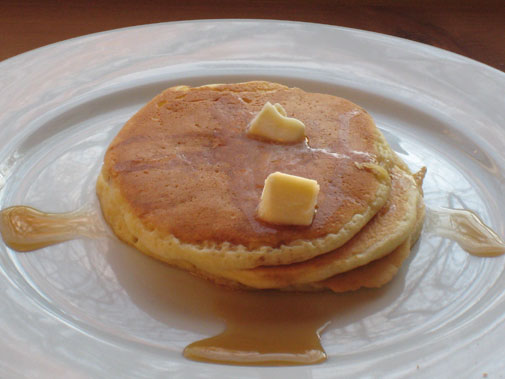
Baking powder or baking soda has been the main leavening agent when making pancakes. However, when using baking soda, buttermilk, which is acidic, must be added to balance baking soda’s basicity.
I rarely keep buttermilk in my fridge. In order to have pancakes that are fluffy without the need of baking soda (still need baking powder), I have added beaten egg whites, also known as “stiff peaks”, into my pancake batter for the extra fluffiness and moisture. The result has been incredible; the pancakes are steamy and soft as usual.
Super Fluffy Pancakes
- 1 cup of all purpose flour
- 1 tablespoon sugar
- 1/2 teaspoon kosher salt
- 1 teaspoon baking powder
- 1 cup whole milk
- 1 teaspoon vanilla extract
- 1 egg
- 2 egg whites, beaten until “stiff peaks” form (using a hand mixer makes the job very easy)
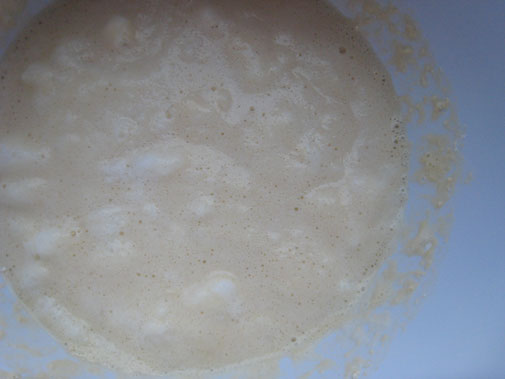
Instructions:
- Mix flour, sugar, salt, and baking power in a large bowl, then whisk the dry ingredients thoroughly.
- Beat the egg and pour milk into it, then pour the mixture into the dry ingredients. Stir the mixture gently to form a batter.
- Use a hand mixer to beat the egg whites, then gently fold the foamy egg whites into the batter and stir until egg whites are combined.
- Heat the griddle with medium heat for few minutes. Lightly brush the cooking surface with butter and scoop the batter onto the griddle slowly.
- Cook each pancake 2 to3 minutes on the first side, then flip it over and cook for another 1 to 2 minutes, until steam comes out of the pancake.
- Drop few knobs of butter in the center of pancakes and drizzle them with good quality maple syrup. Serve immediately.
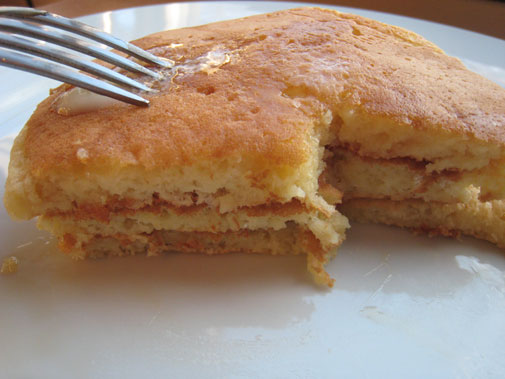
Do you have any great tips for cooking fluffy pancakes?
Tags: Diet
posted on November 18th, 2008 ·
Need a quick meal within 20 minutes? No problem.
I grew up eating a lot of chow mein. My nanny used to make or buy chow mein for me almost everyday because of its convenience and health benefit. A plate of hearty chow mein does not take longer than 20 minutes to make (including prep time), and it is cooked with healthy ingredients, such as bok choy, napa cabbage, Taiwanese cabbage, lean proteins, tofu, and etc.

Guinea Pig’s Chicken Chow Mein
- 3 cloves of garlic
- 2~3 inches long of ginger
- 1 hot pepper, chopped finely
- 1 stalk of scallion
- 3 stalks of Taiwanese cabbage
- 1 cup of chopped shiitake dried mushroom
- 1 handful of enoki mushroom
- 1 medium size, about 3~5 oz. of boneless chicken breast
- two handfuls of egg noodles (1 for next day’s lunch)
- 2 pinches of kosher salt
- 2 tablespoons of low sodium soy sauce*
- few squirts of Sriracha hot sauce
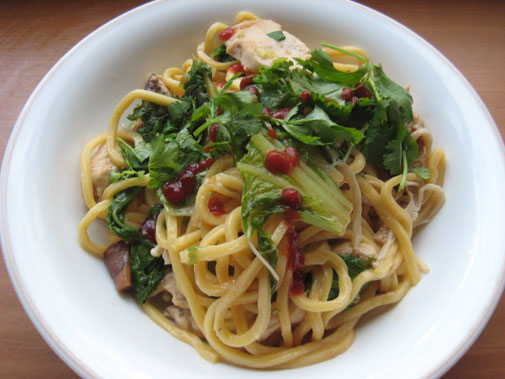
Instructions:
Slice garlic, ginger, scallion, cabbage, and soaked dried mushrooms. Next, boil a pot of water for cooking the egg noodles. While the noodles are being cooked (no more than 2 to 3 minutes), turn on the heat for the wok and wait until it is blazingly hot before adding the Ingredients. Once the wok (or you can use a frying pan) is heated, pour 5 tablespoons of vegetable oil and add the chicken. Start cooking egg noodles in the boiling water as well.
The chicken will be cooked very fast because of the heat, so add the rest of the ingredients into the wok when the chicken is almost done. Stir fry the ingredients for few more minutes and add the cooked noodles. Pour a little bit of water into the wok to prevent food from sticking.
To make the chow mein look silky and smooth, add a tablespoon of corn starch (potato and corn flour are also useful) into the wok and cook until everything looks creamy. Serve immediately.
Chow main is convenient and nutritious, and it is definitely one of my favorite “good eats” when time is not on my side.
*I like using low sodium soy sauce because it helps me season the dish more slowly and carefully.
Tags: Diet
posted on November 18th, 2008 ·
Starting to taper for this Sunday meet.
Warm up:
- 400 freestyle
- 8 x 25 easy pace to sprint
- 300 kicks
Main Sets:
- 4 x 50, under 1:00
- 5 x 100, under 2:00
- 1 x 200 freestyle
- 4 x 50 breast stroke
- 1 x 200 freestyle
- 1 x 200 swim w/ fins
- 200 kicks
Total distance (in meters): 3,000
Tags: Exercise
posted on November 17th, 2008 ·
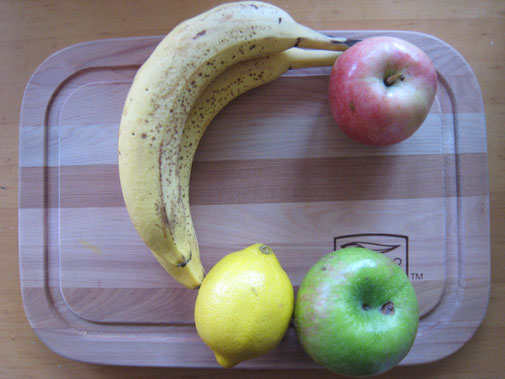
eat your fruits and veggies.
Scurvy is a disease caused by lack of vitamin C. Mild symptons are irritablity and fatigue. More severe damage to your health could be bone degeneration, blood vessel rupture, tooth loss, or respiratory tract infction. U.S. Department of Agriculture recommends consumption of 75~90 mg of vitamin C per day (pg. 6) for adults.
Some of the common fruits and vegetables that have high vitamin C are:
- broccoli*
- cauliflower*
- potatoes*
- Cabbage*
- parsley
- grapefruits
- oranges
- bananas
- apples*
- cranberry*
*currently in season
Pick few items from above each day and you will be scurvy-free!
Tags: Diet
posted on November 14th, 2008 ·
Since moving back to New Jersey in May, I rarely have the opportunities to visit New York City’s Greenmarket. I usually buy my local produce from Schiferstein Farm.
I finally visited New York’s Greenmarket this morning. After not shopping in Union Square Greenmarket for few months, I took my time strolling back and forth and compared prices from each farmer stand.
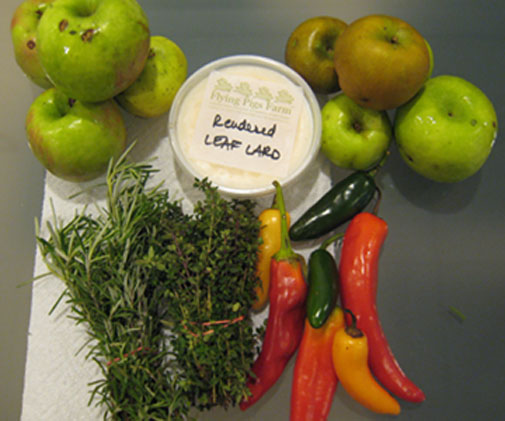
Yup, you saw it…I bought lard! I bought lard to guinea-pig new pie crust recipes. The pigs are raised humanely and given good nutrition in Flying Pig Farm; therefore, I am not afraid to add some pork fat to my food.
- Apples (granny smith, calville blanc, and newton pippin): $3.00
- Chili (Anaheim, Santa Fe Grande, and Jalapeño): $2.45
- Rosemary and thyme: $ 3.50
- Rendered leaf lard: $6.25.
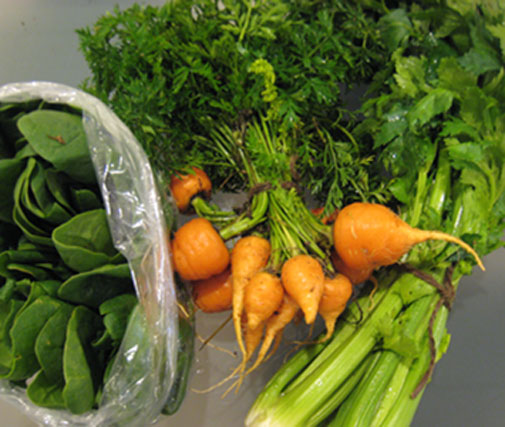
I always like to keep extra celery and carrots in my fridge for making mirepoix.
- Spinach: $3.00
- Nugget carrots: $2.00
- Celery: $2.00
It’s good to be back to New York Greenmarket!
Tags: Diet
posted on November 14th, 2008 ·
Winter squashes (a generic term for all types of squash sold in the market) are everywhere, and they are cheap and delicious. I will be experimenting with a squash recipe every week this fall (possibly in the winter too), and I’d like to share my experiences with you. I hope you will enjoy reading my culinary adventure as well as learning new recipes to cook for your friends and family.
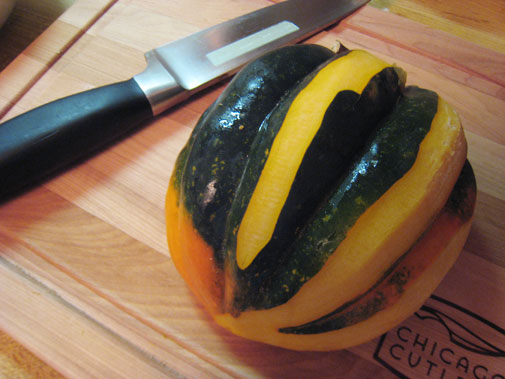
Acorn Squash
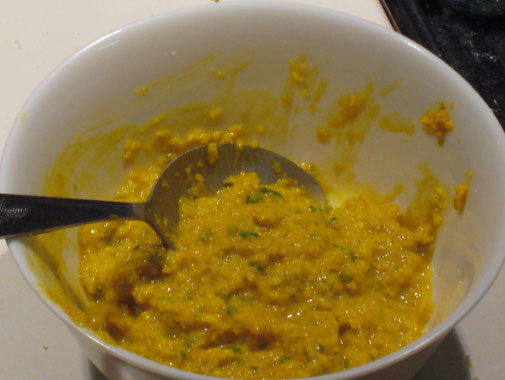
Homemade Curry Paste
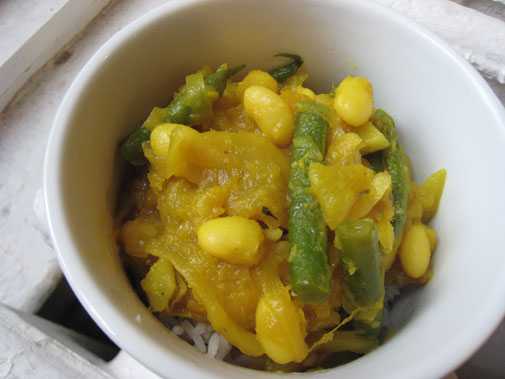
Vegetable Curry.
Acorn squash is a popular ingredient during the holiday season. Simple dish such as roasted acorn squash or stuffed acorn squash has been a steady side dish on our Thanksgiving dinner tables.
Because of acorn squash’s tenderness, I decided to put it in vegetable curry, one of my favorite stews to make during fall season, to complement potatoes’ startchy texture. I also cooked basmati rice, which provided some nutty flavor, to pair with the curry. The curry could have used a little more spice, such as ground fennel, cumin, and coriander seeds for stronger flavor. However, with tender and smooth acorn squash in every bite, I would settle for the mellower flavor.
To make Curry Paste:
- 1 peeled shallots
- 1 inch peeled fresh ginger
- 3 cloves of garlic
- 2 seeded (or not seeded if you prefer some extra heat) chili peppers
- a few tablespoons of turmeric (add more if you prefer more pungent curry flavor)
- 4 tablespoons of groundnut oil, more if needed to form a paste
Blend the above ingredients together in a food processor until smooth and pasty.
To make the Curry Stew:
- 2 medium onions sliced into strips
- 1 handful of string beans chopped to 3 inches in length
- 2 medium potatoes, cubed
- 1-1/2 cup of cooked great northern beans, or any types of legume you prefer
- 4 bay leaves
- chicken broth or water
Cook the curry paste in a pan until the smell of curry comes out.
Saute onions first, make sure to stir occasionally to avoid burnt onions. Once the onions are soft, add the potatoes and cook for another 3 minutes until you can see potatoes turning starchy on the surface.
Add enough chicken broth or water just to cover the ingredients, then add bay leaves and turn the heat to simmer.
Simmer the curry stew for 15 to 20 minutes, until the flavor is developed thoroughly. Take out the bay leaves and add the string beans. Simmer for another 3 to 5 minutes until the beans give you a nice bite, but not too soft.
Serve the curry stew on top of fluffy basmati rice, the traditional rice for a curry dish.
What do you like in your curry stew? Let me know!
Tags: Diet
posted on November 13th, 2008 ·
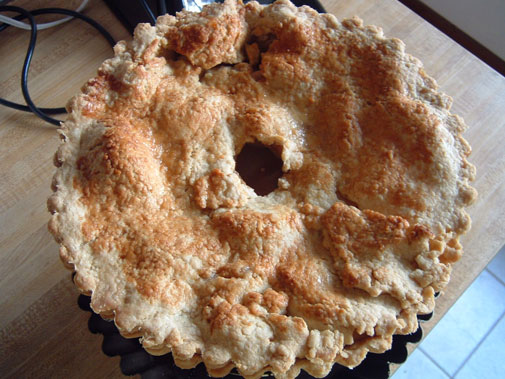
Apple pie take two!
I baked my second apple pie the other day. The pie looked better this time. However, the interior and the overall structure of the pie still needs a lot of improvement. I must have overworked my pie dough; therefore, I got a pie-dome, the hollow space between the top crust and the fillings.
For this particular pie, I used gala, fuji, winesap, and honey crisp apples; they have sweet and mellow flavors. I managed to get the fillings coagulate better this time by adding few more tablespoons of flour. To improve my pie crust next time, I need to distribute the liquid, either cold water or apple jack, more evenly when forming the dough.
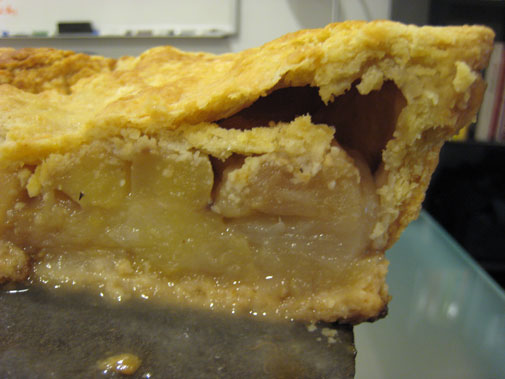
Pie dome under the crust.
A slice of homemade apple pie is a great post-workout meal. A medium slice, about 1-1/2 inch wide, contains enough sugar to replenish glycogen lost during exercise. In addition, apples contain essential vitamins like A, B, and C, and great amount of antioxidant to help us fight cancer. Bake a pie this weekend and share it with your family and friends!
Do you have any great tips for baking a pie?
Tags: Diet
posted on November 13th, 2008 ·
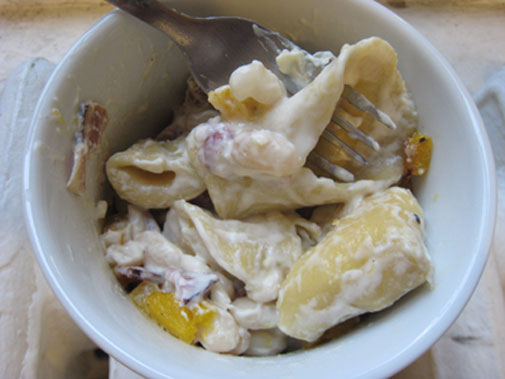
Tortellini is a type of Italian dumpling; these dumplings are versatile and can be served in soup, ragu, or sauteed with a pad of butter on skillet. I love making dumplings from scratch because I can use healthy ingredients for my fillings; I used ricotta cheese and shredded carnival squash for this batch. There are other healthy options such as chopped spinach, parsley, shredded potatoes or sweet potatoes, etc…sky is the limit!
To make tortellini:
Ingredients:
- 100 g of all purpose flour
- 1 egg
- 1 more egg for the egg wash
Instructions:
- Use a food processor or your hands, break the yolk and mix in the flour until “grainy texture” forms
- Form a dough by squeezing the yolk-n-flour mixture together
- Knead the dough for 3 to 5 minutes, until the dough is smooth. Chill the dough for 30 minutes.
- Once the dough is chilled, break it into few equal parts and roll out each portion into a long strip, about 1/2 inch thick.
- Cut the strip into 1/2 inch cubes, like the size of gnocchi. Roll each cube into a little ball and flatten it into a circular sheet with a rolling pin.
- Scoop about 1/4-teaspoon of filling and place it in the middle of the tortellini wrap. Put some egg wash around the outer edge of the wrap and close up the tortellini.
I made creamy great northern bean sauce with crispy bacon to go with tortellini. The sauce was made with sour cream and Pecorino cheese. When making the sauce, use either low heat or make a double-boiler to prevent sauce from burning.
What do you like in your dumpling fillings?
Tags: Diet
posted on November 13th, 2008 ·
Warm up:
- 1 x 15 bird dogs
- 1 x 15 inverted hamstrings
Main sets:
- 5 x 15 straight leg deadlife superset with lateral shoulder raise
- 5 x 15 squat superset with two-arm superman*
- 5 x 15 jump squat superset with inverted hamstring 1-arm rows
- 25 burpee jumps
Tags: Exercise
posted on November 11th, 2008 ·

An athlete (or anyone who plays recreational sports) should still lift weight to maintain muscle mass and strength during the season. To train safely, an athlete’s routine should gear toward sports-specificity; focus on the muscle groups that are important for his or her success in the specific sport. As the season goes on, an athlete can also focus on weaker spots to enhance his or her overall performance.
During the triathlon offseason, I train for competitve swimming. I focus my weight training on my back and shoulders, where I am less developed comparing to experienced swimmers.
- 10 x 10 clean-n-jerk (without the split, I had my feet parallel), 65 lbs. This exercise helps me strengthen for my pull (read “brush thumb”) in the water and lower back stability to maintain a neutral position.
In between sets of clean-n-jerk, I added lower back lifts, swimmers, lower abdominal lifts, and face-down flies (10 to 15 repetitions) to help me develop minor muscle groups for better balance and more flexibility.
Tags: Exercise

















